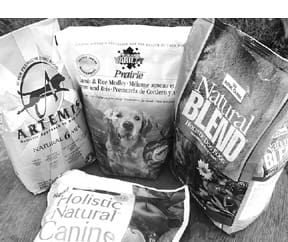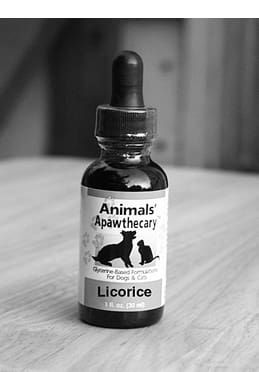Please bear with me for a moment while I brag on Dubhy, our two-year-old Scottish Terrier. From the time we found him as a stray puppy at age six months, we have trained him using methods and management tools consistent with my positive training philosophies. He is the first of our canine family members to be trained completely with modern, non-coercive methods.
Last weekend, we put up a brand-new set of agility equipment in our backyard. As my husband was tightening the last bolt, I dashed into the house to get Dubhy, who has never seen an agility course. To my delight – but not surprise – he happily and willingly traversed even the most daunting of the obstacles on the first go-round. Well, the closed tunnel gave him pause for a moment. When he couldn’t see his way through the collapsed chute, he jumped on top of the barrel instead, and perched there happily, sending me a cheerful “Is this what you wanted?” query from his sparkling eyes. When I invited him off the barrel and opened the chute to show him the way through, that obstacle, too, was quickly conquered.
I’ve had other dogs who were just as smart as Dubhy, but until the feisty Scottie came along, I had not yet owned a dog that I trained completely without compulsion: No “ear pinches,” yanks on the collar, knees in the chest, stepped-on toes, or any other physical “corrections” whatsoever. And, oh! What a difference it can make.
Don’t get me wrong; I have not used coercive training techniques for more than 12 years. I was totally and completely converted to “positive-only” training techniques following a moral, professional crisis with another one of my dogs a dozen years ago. Since then, I’ve used only “dog-friendly” training methods with thousands of dogs and seen ample proof that these effective methods encourage and foster a strong, trusting bond between dogs and their owners.
However, until Dubhy, I had never so clearly seen the difference between a “crossover” dog – one who was initially trained with force-based methods and then switched to positive-only training – and a dog who had never experienced scary, hurtful, or force-based training. They are, as the saying goes, completely different animals.
Crossover consequences
Take, for example, Josie, the canine love of my life. The Terrier mix was a joyful and willing worker, and we accomplished a lot together, including titles in competitive obedience and Rally. Josie was also my first “crossover” dog; until she was three years old, I had trained her with conventional force-based methods. Josie prompted my conversion one day when she hid under the deck and unhappily refused to come out when she saw me getting out a set of retrieving dumbbells in preparation for a training session. (I had been working to teach her to retrieve using a conventional coercive training method, the ear-pinch.)
After this incident, I took a two-year time-out from training to learn about modern, positive methods that are grounded in the science of behavior and learning. Only then did I begin training Josie again. This time, I used only dog-friendly training methods, and she responded beautifully. Our accomplishments continued apace.
But throughout the rest of her life, Josie’s response to new training situations or requests was very different from Dubhy’s eager and creative volunteerism. The best way I can describe this is that when faced with something new, she waited to be shown what to do – as do many crossover dogs. My guess is that her fear or anxiety about doing the wrong thing was stronger than any impulse she might have had to try to guess what I wanted – even though, for the last 12 years of her life, she was never punished for doing the wrong thing.
In other words, faced with a unique training request, crossover dogs like Josie tend to do nothing, or offer a safe behavior that they already know.
Why positive methods work
In contrast, Dubhy and other dogs who were encouraged since infancy to “offer” novel behaviors in response to new training requests, joyfully go to work trying to solve the puzzle. The modern methods of training teach, foster, and capitalize on this initiative; the dog’s volunteerism is what makes it works so well.
In positive training, the goal is to help the dog do the right thing and then reward him for it, rather than punishing him for doing the wrong thing. If he makes a mistake, the behavior is ignored, or excused with an “Oops, try again!” to encourage the dog to do something else. Using “Oops!” as a “no-reward marker” teaches the dog that the behavior he just offered didn’t earn a reward, but another one will. So he tries again, and learns to keep trying until he gets it right, without fear of punishment.
In early training, he only needs to get it a “little bit right” to earn a Click! and reward; the goal is always to help the dog succeed, to keep him confident and willing to play the training game. In the beginning, for example, the dog is rewarded for walking in the general area of “heel” position, in order to learn to walk politely on his leash. If competition heeling is desired, this can be “shaped” later for more precision by clicking closer and closer approximations to “perfect” heel position. He learns where he needs to be to make good stuff happen through repetition or rewards, and volunteers to be there because he likes good stuff.
In contrast, force-based training teaches the dog to heel by administering a sharp jerk (pop) on the leash any time the dog steps out of heel position. He learns where he needs to be in order to avoid bad stuff through repetition of punishment, and stays in heel position because he doesn’t want to get hurt.
Both methods can teach dogs to be well-behaved. The force-trained dog learns to watch and read people, in large part in order to avoid the negative consequences that occur when he makes a mistake. The praise and rewards that sometimes follow a correction are rarely enough to overcome the learned caution of trying some new behavior that might be punished. The positive dog also learns to watch and read the humans around him, so that he can take advantage of opportunities to offer good behaviors that are likely to result in good stuff. He has no fear of offering behaviors, because he has no anticipation of a painful consequence.
Obedient but inhibited
Despite 12 years of positive training and relationship-building, I know that Josie would not have addressed the agility course with the aplomb that Dubhy demonstrated. She surely would not have hopped on top of a slippery barrel to see if that might be an alternative rewardable behavior. This is due at least in part, I believe, to their different personalities. Dubhy is sturdy and stalwart, and possesses the typical terrier “no-fear” attitude. Josie was soft, sensitive, and cautious.
I am also sure that Josie’s lack of confidence about trying new things was equally due to her early training experiences, when she learned that unasked-for behaviors often got punished, and that the safest course of action was to wait to be told or shown what to do.
Dubhy, on the other hand, has consistently been encouraged and rewarded for offering behaviors. Give him a new object, and he immediately sets to work trying to figure out what he is supposed to do with it. Give him a whole agility course, and he immediately tries to figure out what he is supposed to do with each of the various pieces of equipment.
Crossover history
Of course, I’m not the only one who has witnessed the vast differences between crossover dogs and those started from scratch with positive training.
The phrase “crossover dog” was actually coined in the 1990s as a result of the large influx of trainers who found themselves switching over from old-fashioned methods to more positive training. In her landmark book, Don’t Shoot the Dog, former marine mammal trainer Karen Pryor introduced the dog-training world to the exquisite method of positive training known as clicker training. As dog trainers learned about the effectiveness of the techniques, many of them, too, “crossed over” to positive training methods. As Pryor has said, “In the early 90s, I could count the number of clicker trainers on one hand. Now there are thousands of us!”
Crossing with your dog
As trainers cross over – professional and average dog owners alike – they encounter the challenge of teaching their crossover dogs a whole new approach to training. The phenomenon that I observed with Josie – her reluctance to freely offer new behaviors – is often discussed among professional positive trainers. We asked several well-known trainers to share their thoughts on the challenges of working with crossover dogs – and humans. Here’s what they said.
DEBORAH A. JONES, Ph.D.
Assistant Professor of Psychology,
Kent State University, Ohio
Deb Jones is a college professor, author, producer of the excellent Click and Go video series, and a positive dog trainer. Her first performance dog was an adult rescue Labrador Retriever. Katie came to Dr. Jones with the pejorative label of “stubborn.” Fortunately for the dog, Jones understood that Katie had simply learned to tune out and withstand unpleasant training techniques by shutting down and doing nothing.
In Jones’ hands (and with clicker training), Katie’s whole attitude and demeanor changed; she competed happily and successfully in obedience, and became a fantastic therapy dog.
Jones agrees that the differences between crossover dogs and positive-trained dogs are easy to see. “Usually, crossover dogs have learned from their training that ‘when in doubt, it’s best to do nothing.’ If they have been punished for making mistakes in the past, they have learned the concept that trying new things gets them in trouble.
“Dogs who have been exposed only to positive methods, however, are willing and eager to try new things. They are active in the training process, rather than waiting for explicit instructions. They also tend to be creative, which is a great asset when trying to shape or capture new behaviors.”
Jones estimates that 95 percent of her human and canine clients are crossovers, and that people are eager to find ways to train that don’t involve force and compulsion. While Jones herself never used old-fashioned methods, she watches her human clients struggle with crossing over, in part because old habits are hard to break, but also because they had accepted the old myth that effective dog training requires the use of force, compulsion, and intimidation. “But as soon as they see that there is another way,” she says, “most are very willing to give it a try, and are happy with the results.”
JEAN DONALDSON
Founder/Instructor, The San Francisco
SPCA Academy for Dog Trainers
Jean Donaldson is the author of the highly regarded book, The Culture Clash, as well as Dogs Are From Neptune, and MINE!, A Guide to Resource Guarding in Dogs. She lectures extensively in the U.S., Canada, and abroad.
Donaldson agrees that crossover dogs are generally less willing to take risks, and suggests that they can even display “learned helplessness.” This is characterized by apathy, immobility, and nonresponse to stimuli in cases where the dog cannot avoid – or does not know how to avoid – the aversive (punishment) that is applied by the trainer. “So,” she says, “when the trainer crosses over, a training session has a great deal of baggage and it may take time for the dog to learn that aversives are no longer forthcoming.”
She sees fallout even in dogs trained with lots of luring and physical prompts (as opposed to free-shaping – waiting for the dog to perform a behavior and then click-rewarding it). Donaldson also suggests that these dogs may be less willing to offer behavior, as the lured and prompted dog has learned to wait for the trainer to show him what the answer is, rather than offering behaviors to figure it out himself.
Contemplating the crossover question, Donaldson muses, “Isn’t it hard to imagine how anyone in 2002 has not crossed over, given the track record of positive reinforcement training, and readily available information on it?”
LESLIE NELSON
Tails-U-Win! Canine Center,
Tolland, Connecticut
Leslie Nelson was one of the early icons in positive training, and continues to supervise more than 50 classes a week as director of her Tails-U-Win! training center. She feels that dogs adjust more easily to crossing over than many humans do, and recalls her own crossing-over struggle. “I can remember well, many years ago, when I made the decision to switch to all positive training,” she says. “In the beginning I had to work totally without a leash [in order to resist making leash corrections]. Old habits die hard.”
Nelson finds that most crossover dogs respond enthusiastically to positive training, although they can have some difficulty with pure clicker training and shaping, and may find the new approach stressful at first.
“They can be very reluctant to offer new behaviors for fear of being wrong,” says Nelson. “Fortunately,” she adds, “positive reinforcement training offers a variety of choices and can be adapted to meet the needs of each dog. Crossover dogs can be very successful when trained using a combination of luring (using a treat to get the dog to offer the behavior), targeting (teaching the dog to touch his nose to a designated target), and modeling (using gentle physical assistance to help the dog into the desired position).”
KAREN OVERALL, MA, VMD, Ph.D., ABS
Certified Animal Behaviorist,
University of Pennsylvania, Philadelphia
Dr. Overall is an internationally renowned researcher, author, speaker, and behaviorist whose best-selling textbook, Clinical Behavioral Medicine for Small Animals, is a bible for trainers who do behavior work.
True to her academic background, Overall was reluctant to speculate without solid research to back up her opinions. She offered that because dogs learn so well from context, they probably cope better with crossing over than most humans do.
According to Overall, dogs rely so much on nonverbal signaling (body language) and olfactory communication (sense of smell) that we can’t lie to them easily. Thus, when we humans truly commit to positive training, our whole nonviolent message is clearly communicated to our dogs.
Because, however, as Nelson says, “Old habits die hard,” we sometimes send mixed messages, when we inadvertently or deliberately revert to using punishment-based methods that worked for us before.
Overall suggests that dogs closer to the edge – more uncertain, anxious, roughly-handled dogs – will have more difficulty with crossing over. She says, “It likely all comes down to how well the dog can read the rules, and how damaged they are. The longer I go on, the more I am convinced that ‘normal’ is defined by how well you recover.”
Patience begets progress
The trainers we interviewed all seemed to agree (as do we) that punishment-based training causes damage (mental if not always physical) and that crossover dogs must recover from that damage as part of the crossing-over process. The degree of success in that recovery varies depending on a number of factors including the dog’s personality, the amount of damage done, and the skill and consistency the owner/trainer demonstrates in her commitment to and application of positive methods.
Dr. Jones offers some final words of wisdom for humans who embark on the crossover journey.
“Be patient,” she counsels. “Your dog has to unlearn old information before he can completely participate in your new way of training. Progress should occur on the dog’s timetable, not yours. Let him discover that trying new things is reinforced, not punished. Let go of the idea that you control the training process, and let your dog be an active participant.”
A year ago, my husband and I said heart -wrenching goodbyes to my first crossover dog, Josie, when she let us know that her 15-year-old body was too tired to carry on in this world. I am eternally grateful to her for showing me the way to be a more compassionate trainer and human. And I will always regret the three years of measured punishment I inflicted on her, using the methods I had been taught before I learned a better way. If I could change just one thing in my life, I would take back those three years of collar corrections, verbal aversives, and ear pinches that I imposed on my beloved dog, before she taught me a better way. I can see Josie in my mind’s eye even now, running the agility course in our backyard next to Dubhy, sharing his joy, confidence, and faith in a positive world.


















